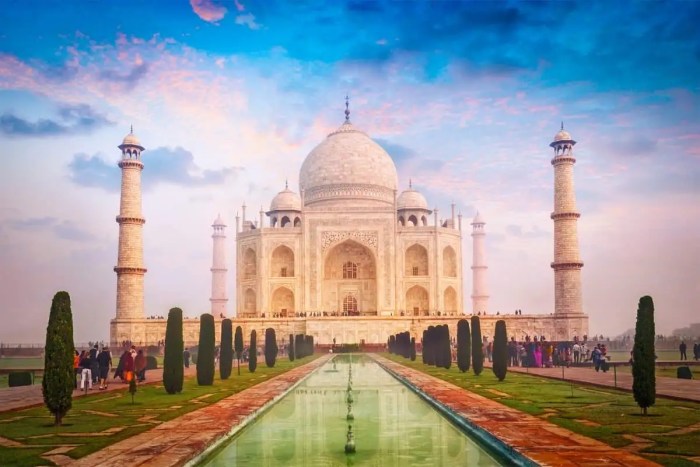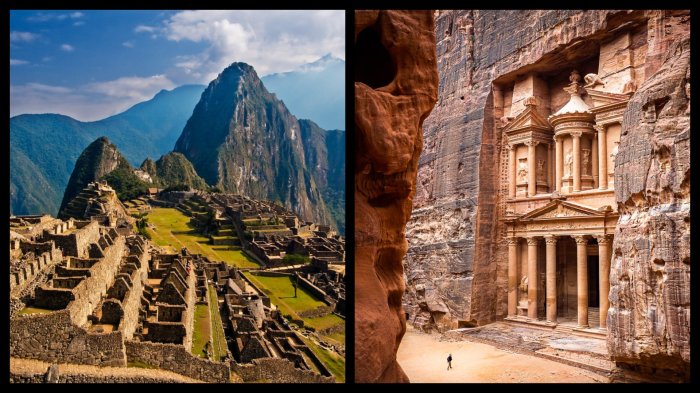UNESCO World Heritage Sites stand as testaments to the rich tapestry of human culture and the awe-inspiring beauty of nature. Recognized for their exceptional value, these sites have been inscribed on the World Heritage List to ensure their protection and preservation for generations to come.
From ancient cities and architectural wonders to breathtaking landscapes and diverse ecosystems, UNESCO World Heritage Sites encompass a vast array of cultural and natural treasures. They serve as living reminders of our shared heritage and the importance of safeguarding our planet’s most precious assets.
Cultural Significance of UNESCO World Heritage Sites

Preserving cultural heritage is crucial for maintaining the collective memory of humanity and fostering cultural diversity. UNESCO recognizes the importance of protecting exceptional cultural and natural sites by designating them as World Heritage Sites.
To qualify as a World Heritage Site, a site must meet at least one of ten selection criteria established by UNESCO. These criteria assess the site’s:
- Cultural significance
- Historical importance
- Architectural or artistic value
- Unique natural features
Examples of iconic cultural UNESCO World Heritage Sites include:
- The Great Wall of China, China
- The Taj Mahal, India
- The Colosseum, Italy
- The Pyramids of Giza, Egypt
- The Machu Picchu, Peru
Natural Heritage Sites

The preservation of natural heritage sites is of utmost importance for several reasons. Natural heritage sites are areas of exceptional natural beauty, scientific significance, or cultural importance. They provide vital habitat for wildlife, protect ecosystems, and serve as a source of inspiration and enjoyment for people worldwide. Preserving these sites ensures that future generations can appreciate the wonders of the natural world.
UNESCO World Heritage Sites are unique natural areas that have been recognized for their outstanding universal value. They represent the most exceptional and significant natural heritage on the planet. These sites encompass a wide range of ecosystems, including forests, mountains, deserts, wetlands, and oceans. They are home to a vast array of plant and animal species, many of which are rare or endangered.
Breathtaking Natural UNESCO World Heritage Sites
- Great Barrier Reef, Australia: The largest coral reef system in the world, home to an astonishing array of marine life.
- Grand Canyon, United States: A vast and awe-inspiring gorge carved by the Colorado River over millions of years.
- Amazon Rainforest, Brazil: The largest rainforest in the world, home to an estimated 10% of the world’s known species.
- Yosemite National Park, United States: A stunning mountain wilderness with towering granite cliffs, cascading waterfalls, and giant sequoia trees.
- Serengeti National Park, Tanzania: One of the largest and most famous national parks in Africa, known for its vast herds of wildlife, including lions, elephants, and zebras.
Management and Conservation

Preserving UNESCO World Heritage Sites poses multifaceted challenges. Natural disasters, climate change, human activities, and limited resources hinder the conservation of these invaluable assets.
The Caribbean is renowned for its stunning beaches, from the pristine white sands of Jamaica’s Negril Beach to the turquoise waters of the best beaches in the Caribbean. While enjoying the sun and surf, don’t forget to explore the region’s rich cultural heritage.
Several UNESCO World Heritage Sites, such as the Blue and John Crow Mountains National Park in Jamaica and the Historic Bridgetown and its Garrison in Barbados, offer a glimpse into the Caribbean’s past and present.
Role of Local Communities
Local communities play a crucial role in safeguarding World Heritage Sites. They possess indigenous knowledge and traditional practices that contribute to conservation efforts. Their involvement fosters a sense of ownership and encourages sustainable management practices.
Role of International Organizations
International organizations like UNESCO and the World Bank provide technical and financial assistance to World Heritage Sites. They collaborate with local authorities to develop management plans, monitor conservation efforts, and raise awareness about the importance of these sites.
When planning a family vacation, consider exploring UNESCO World Heritage Sites. These exceptional cultural and natural landmarks offer enriching experiences for all ages. From the awe-inspiring pyramids of Egypt to the vibrant streets of Istanbul, these sites showcase the world’s diverse heritage.
For more family-friendly destinations, check out best family vacation spots. UNESCO World Heritage Sites not only provide educational opportunities but also create lasting memories that will be cherished for a lifetime.
Case Studies
Successful conservation efforts have been implemented at several World Heritage Sites:
- Angkor Wat, Cambodia: Collaborative efforts between the Cambodian government, UNESCO, and local communities have led to the restoration and preservation of this iconic temple complex.
- Great Barrier Reef, Australia: The Australian government and international organizations have implemented conservation measures to protect this vast coral reef ecosystem from pollution, climate change, and overfishing.
- Yellowstone National Park, USA: Partnerships between the National Park Service, Native American tribes, and conservation groups have ensured the protection of this iconic wilderness area.
Tourism and UNESCO World Heritage Sites
Tourism has become an increasingly significant factor in the management and preservation of UNESCO World Heritage Sites. While it can provide economic benefits and raise awareness of these sites, it can also pose challenges to their integrity and authenticity.
Positive impacts of tourism on UNESCO World Heritage Sites include:
- Economic benefits: Tourism can generate revenue for local communities, governments, and businesses, which can be used to support conservation efforts and improve infrastructure.
- Increased awareness: Tourism can raise awareness of the importance of these sites and promote their protection.
- Cultural exchange: Tourism can facilitate cultural exchange between visitors and local communities, fostering understanding and appreciation of different cultures.
Negative impacts of tourism on UNESCO World Heritage Sites include:
- Environmental degradation: Mass tourism can lead to environmental degradation, such as pollution, erosion, and habitat destruction.
- Crowding and congestion: Excessive tourism can result in overcrowding and congestion, which can detract from the visitor experience and damage fragile ecosystems.
- Cultural erosion: Uncontrolled tourism can lead to the erosion of traditional cultures and values, as well as the commodification of cultural heritage.
Strategies for Managing Tourism
To address these challenges, UNESCO has developed a number of strategies for managing tourism at World Heritage Sites. These include:
- Visitor management plans: These plans establish limits on the number of visitors and regulate their behavior to minimize negative impacts.
- Infrastructure development: Improving infrastructure, such as transportation and waste management systems, can help to reduce the environmental impact of tourism.
- Education and interpretation: Providing visitors with information about the importance of these sites and how to behave responsibly can help to reduce their impact.
- Community involvement: Involving local communities in tourism planning and management can ensure that the benefits of tourism are shared and that their cultural heritage is respected.
Examples of Sustainable Tourism Practices
Many UNESCO World Heritage Sites have implemented sustainable tourism practices to minimize their environmental and cultural impact. These practices include:
- Limiting visitor numbers: Some sites, such as the Great Barrier Reef in Australia, have implemented strict limits on the number of visitors allowed per day.
- Using eco-friendly transportation: Some sites, such as the Galapagos Islands in Ecuador, require visitors to use electric vehicles or walk to minimize air pollution.
- Promoting cultural sensitivity: Some sites, such as the Angkor Wat temple complex in Cambodia, have implemented programs to educate visitors about local customs and traditions.
Global Representation: UNESCO World Heritage Sites

UNESCO World Heritage Sites are distributed across the globe, representing a diverse range of cultural and natural heritage. These sites are concentrated in certain regions, showcasing the richness and diversity of our planet.
Distribution of UNESCO World Heritage Sites
An interactive map or table can illustrate the global distribution of UNESCO World Heritage Sites. This visualization would highlight the regions with the highest concentrations of sites, such as Europe, Asia, and Latin America.
Diversity of Cultural and Natural Heritage
The UNESCO World Heritage Sites represent a wide range of cultural and natural heritage. Cultural sites include historic monuments, archaeological sites, and cultural landscapes. Natural sites include national parks, forests, and geological formations. This diversity reflects the richness of human history and the natural wonders of our planet.
Regions with High Concentrations of UNESCO World Heritage Sites
Some regions have a higher concentration of UNESCO World Heritage Sites than others. For example, Europe has over 500 sites, while Africa has around 100. This disparity is due to a combination of factors, including historical significance, cultural diversity, and conservation efforts.
Educational Value

UNESCO World Heritage Sites possess immense educational value, serving as invaluable resources for fostering cultural understanding and environmental awareness. These sites offer a tangible connection to the past, allowing us to delve into different cultures, historical events, and natural wonders.
UNESCO World Heritage Sites offer awe-inspiring destinations for families seeking enriching experiences. These sites encompass natural wonders, cultural treasures, and historical landmarks that educate and entertain. While planning budget family vacations , consider incorporating a visit to a UNESCO World Heritage Site.
These sites not only provide unforgettable memories but also foster a deeper appreciation for our planet’s diverse heritage.
Promoting Cultural Understanding
- World Heritage Sites showcase the diversity of human creativity, showcasing architectural marvels, artistic masterpieces, and traditional practices.
- They provide a platform for intercultural dialogue, enabling people from different backgrounds to appreciate and learn from one another’s heritage.
- These sites foster a sense of global citizenship, promoting respect and understanding for diverse cultures and ways of life.
Enhancing Environmental Awareness
- Natural Heritage Sites highlight the importance of biodiversity conservation and ecosystem protection.
- They serve as living laboratories for scientific research, providing valuable insights into the natural world and its processes.
- These sites raise awareness about environmental issues, inspiring visitors to adopt sustainable practices and advocate for the protection of our planet.
Educational Programs and Initiatives
- UNESCO World Heritage Centres offer educational programs, guided tours, and workshops designed to engage visitors and promote knowledge about the sites.
- Schools and universities incorporate World Heritage Sites into their curricula, providing students with hands-on learning experiences and fostering a lifelong appreciation for history and culture.
- Community-based initiatives empower local communities to become stewards of their heritage and share their knowledge with visitors.
Last Word

As we continue to navigate the challenges of the modern world, UNESCO World Heritage Sites provide invaluable insights into our past and inspire us to build a more sustainable and equitable future. By protecting and celebrating these remarkable places, we not only preserve our cultural and natural legacy but also foster a greater understanding and appreciation for the diversity of our world.
FAQs
What is the purpose of UNESCO World Heritage Sites?
UNESCO World Heritage Sites are designated to protect and preserve cultural and natural sites of outstanding universal value for future generations.
How are sites selected as UNESCO World Heritage Sites?
Sites are selected based on rigorous criteria that assess their cultural, historical, scientific, or natural significance, as well as their authenticity and integrity.
What are some examples of UNESCO World Heritage Sites?
Iconic cultural sites include the Great Wall of China, the Taj Mahal, and the Colosseum, while natural sites include the Grand Canyon, the Great Barrier Reef, and the Serengeti National Park.